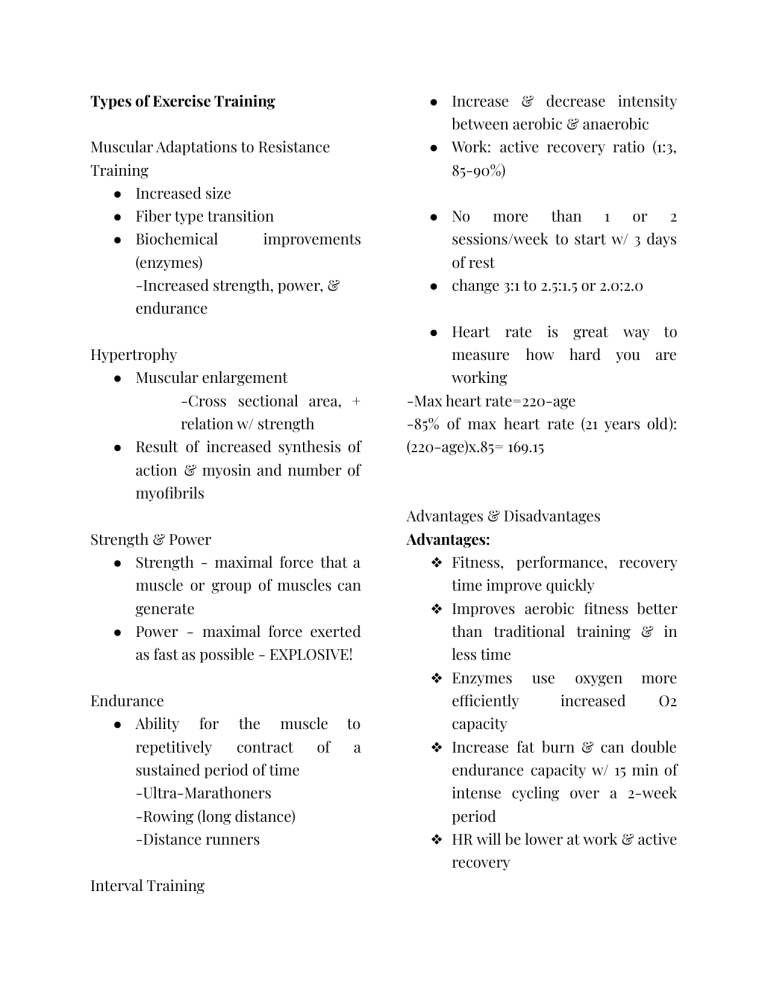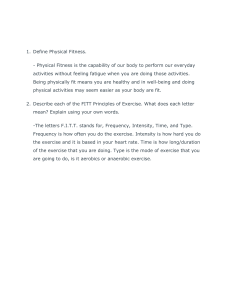
Types of Exercise Training ● Increase & decrease intensity between aerobic & anaerobic Muscular Adaptations to Resistance ● Work: active recovery ratio (1:3, Training 85-90%) ● Increased size ● Fiber type transition ● Biochemical ● No improvements (enzymes) more than 1 or 2 sessions/week to start w/ 3 days of rest -Increased strength, power, & ● change 3:1 to 2.5:1.5 or 2.0:2.0 endurance ● Heart rate is great way to Hypertrophy measure ● Muscular enlargement how hard you are working -Cross sectional area, + -Max heart rate=220-age relation w/ strength -85% of max heart rate (21 years old): ● Result of increased synthesis of (220-age)x.85= 169.15 action & myosin and number of myofibrils Advantages & Disadvantages Strength & Power Advantages: ● Strength - maximal force that a muscle or group of muscles can generate ❖ Fitness, performance, recovery time improve quickly ❖ Improves aerobic fitness better ● Power - maximal force exerted as fast as possible - EXPLOSIVE! than traditional training & in less time ❖ Enzymes Endurance ● Ability efficiently for repetitively the muscle contract of to a use oxygen more 🡪increased O2 capacity ❖ Increase fat burn & can double sustained period of time endurance capacity w/ 15 min of -Ultra-Marathoners intense cycling over a 2-week -Rowing (long distance) period -Distance runners ❖ HR will be lower at work & active recovery Interval Training Disadvantages: TYPE OF FLEXIBILITY ❖ Performed too often can increase risk of overtraining ❖ bad knees Relates to the range of movement only. avoid intervals walking, running or jogging STRETCHING: The process of elongating the tissue. ❖ Stop exercise if it hurts & modify workout ❖ Check STATIC: EXAMPLES OF STRETCH ACTIVITIES FOR EACH TYPE OF FLEXIBILITY with doctor before starting interval training • Stretch to the furthest point, and hold • It is the safest method • Simple to carry out High Intensity Interval Training • Requires little energy (HIIT) • It allows time for the muscle fibers to -HIIT also manages to provide the near relax perfect solution to those who have little • e.g. holding a "split" position time to exercise but still need to do something in order to maintain the BALLISTIC: Bouncing, rebounding and physical fitness levels required for a rhythmic motion. Momentum takes the healthy mind and body. moving limb or part of the body to its limits in order to increase the Cross-Fit range of movement (e.g. swinging, -CrossFit workouts carried more risk flinging and bobbing). than traditional weightlifting DYNAMIC: This refers to the ability to use a full range of movement in the Flexibility Training performance of a physical activity at ● The ability to move muscles and normal speed of the action. It is joints through their full ranges of performed under control and does not motion end with jerky movements. For these ● Improve efficiency of movement types of flexibility: and technique - this helps to • The risk of injury is greater save energy • They do not give time for the tissue to ● Increase other physical fitness components agility e.g. speed and adapt • Can increase muscle tension ACTIVE FLEXIBILITY: Can be static or Overexerting dynamic. It refers to the range of movement an individual can carry out Beware of pushing yourself too hard too without assistance. often. If you are short of breath, are in pain or can't work out as long as you'd PASSIVE FLEXIBILITY: The individual planned, your exercise intensity is makes no contribution to the motion probably higher than your fitness level and an external force is applied - a allows. Back off a bit and build intensity partner assists or the person pulls gradually. himself or herself into the extended position. HOW TO HIT YOUR TARGET HEART RATE? PHYSICAL INDICATORS The American Heart Association Moderate exercise intensity generally recommends a target heart rate of: Moderate activity feels somewhat hard. Moderate exercise intensity: 50% to Here are clues that your exercise about 70% of your maximum heart rate intensity is at a moderate level: Vigorous exercise intensity: 70% to -Your breathing quickens, but you're about 85% of your maximum heart rate not out of breath. -You develop a light sweat after about 10 minutes of activity. HOW WILL YOU CALCULATE YOUR -You can carry on a conversation, but TARGET you can't sing. AEROBIC EXERCISE? HEART RATE DURING *You can calculate your maximum heart Vigorous exercise intensity rate by subtracting your age from 220. Vigorous activity feels challenging. Here For example, if you're 45 years old, are clues that your exercise intensity is subtract 45 from 220 to get a maximum at a vigorous level: heart rate of 175. This is the average -Your breathing is deep and rapid. maximum number of times your heart -You develop a sweat after only a few should beat per minute during exercise. minutes of activity. -You can't say more than a few words without pausing for breath. Heart Rate Reserve is located on the thumb side of your 1. 220- age = Maximum Heart Rate wrist. 2. Subtract resting heart rate from Max HR=Heart Rate Reserve (HRR) Step 3: Multiply this number by 4 to 3. Multiply HRR times percent you want calculate your beats per minute. to train at. 4. Add back resting heart rate. Here's an example: You stop exercising and take your pulse for 15 seconds, Assuming a resting heart rate of 70 getting 37 beats. Multiply 37 by 4, to bpm, 27 years old and 70% training reach 148. If you're 45 years old, this range: puts you in the target heart rate zone for vigorous exercise, since the target 220-27=193 zone for that age is between 146.5 and 193-70=123 160.75 beats per minute using the HRR 123x70%=86 method. If you're under or over your 86 + 70= 156 target heart rate zone, adjust your 220-15=179 exercise intensity. 179-78=101 101x70%=70.7 RATING OF PERCEIVED EXERTION 70.7 + 78=148.7 (RPE) CHECK YOUR HEART RATE DURING -is a tool for measuring an individual’s EXERCISE: effort and exertion, breathlessness and fatigue during physical work and so is Step 1:Stop briefly. highly relevant for occupational health Step 2: Take your pulse for 15 seconds. and safety practice. To check your pulse over your carotid artery, place your index and third fingers on your neck to the side of your windpipe. To check your pulse at your wrist, place two fingers between the bone and the tendon over your radial artery — which 7 HEALTHY HABITS 1. Choose nutritious and varied options -Chronic injuries are caused by continuous stress on a body part over a long time. 2. Manage portions -Caused by training too hard, not 3. Choose to drink water or milk allowing 4. Enjoy meals together footwear and bad technique. time for recovery, poor 5. Play actively 6. Keep good hygiene 7. Care for the planet PRICE MANAGEMENT Protection Rest Proper Etiquette and Safety in Home Based Exercise Injuries Dislocation- joint displaced Ice Compression Elevation Bruise-soft tissue injury Sprain- overstretched ligaments RICE Fracture- cracked or broken bone Rest Concussion- injury to the brain Ice Compress Injury diagnosis Elevate ● Talk ● Observe NO H.A.R.M ● Touch Heat ● Active movements Alcohol ● Passive movements Running ● Skills test Massage Acute Injuries HARD AND SOFT TISSUE INJURIES -Acute injuries occur when there is Hard injuries are bone injuries. sudden stress on the body. Soft tissue injuries involve damage to Chronic injuries skin, muscles, tendons, ligaments or 1. Stress fracture cartilage. 2. Tendinopathy/Tendinitis 3. Osteoarthritis 4. Bursitis Soft tissue injuries usually caused by prolonged exposure -An open injury means that the skin has to cold temperatures. been broken – blood usually escapes. -Open injuries include cuts, grazes, Dehydration- When we exercise, blisters and chafing. especially in hot conditions, the body -A closed injury occurs beneath the loses water as a result of sweating. skin – there is no external bleeding. Unconsciousness- Concussion is a Open injuries common cause of unconsciousness -Cuts require immediate attention to while playing sports. stop bleeding and allow the blood to clot. D.R.A.B.C MANAGEMENT -Grazes or abrasions where skin is Danger scraped off the body, need to be cleaned Response carefully. Airway -Blisters are caused by the skin rubbing Breathing on other surfaces. Circulation -Chafing is caused by ill-fitting clothing or material. Closed injuries -Bruises occur when small blood vessels are damaged by an impact or sudden wrenching movement. -Sprains occur when ligaments at joints get stretched and torn. -Strained muscles result from muscles being suddenly and forcefully -A dislocation occurs when a bone is pulled or twisted out of place at a joint. Hard tissue injuries-are bone fractures – the bone either cracks or breaks. Hyperthermia- is a potentially dangerous drop in body temperature, Proper Etiquette and Safety in -Do it right. Home Based Exercise Injuries -Check your gear. -Be sensible, especially at night or in 8 Signs You Should Stop Exercising 1) Abrupt dizziness, an secluded areas. irregular heartbeat or unusual shortness of breath. GYM ETIQUETTE GUIDE 2) You “feel the burn." 1. Read and memorize the gym rules. 3) Pain or tenderness that doesn’t go 2. Wipe down the equipment that you away. used when you are done. 4) Chills, headache, severe muscle 3. Get to it. burning or blurred vision. 4. Do not bring your cell phone there 5) Sore, stiff muscles the day after a with you. workout session. 5. Try to keep the 'sound effects' to a 6) An elevated heart rate upon minimum. awakening. 6. When you're done using the weights, 7) Starting too quickly put them back in the proper place. 8) Swelling or pain in joints. 7. Avoid hogging machines. 8. Put on your deo before arriving at the Exercises that could be harmful gym. -Bouncing while stretching 9. If you see someone that looks like -Standing toe-touches they might need a spotter, be ready to -Deep (full) squat step in and do it for them. -Sit-up 10. -Double leg raises personal space is. -Behind the neck press 11. Do the lift properly. Pay attention to where your 12. Take your calls outside. Stretching and exercise safety 13. Use the right weights. -Be aware of your body. 14. Be on time for group classes. -Warm up and cool down. 15. Use the locker room. -Pace yourself. 16. Prevent wardrobe malfunctions and -Mix it up. get some proper attire. -Strap or tape. 17. Ask for help. -Stay hydrated. -Be weather aware. FITT Principle & Muscular Strength Workout Plan The FITT Principle (or formula) is a great way of monitoring your exercise program. The acronym FITT outline the key components, or training guidelines, for an effective exercise program and the initials F.I.T.T stands for: Frequency, Intensity, Time and Type. Frequency-Refers to the number of times per week you engage in physical activity or exercise. Intensity-The difficulty or exertion level of your physical activity or exercise. Time-The duration of a single workout, usually measured in minutes or hours. Type-The particular type of physical activity or exercise you choose to do. Workout Plan Components A repetition, or rep, is the most basic component of a resistance-training program. Skeletal muscles work together to produce two complementary, opposing, actions: contraction and extension. Stages of Personal Fitness Progress 1. Initial Stage 2. Improvement Stage 3. Maintenance Stage or

